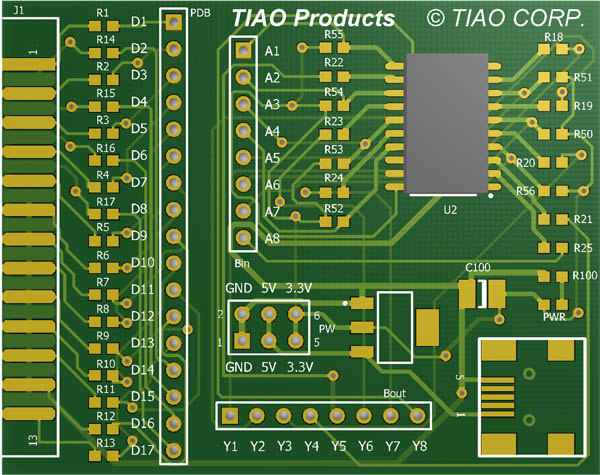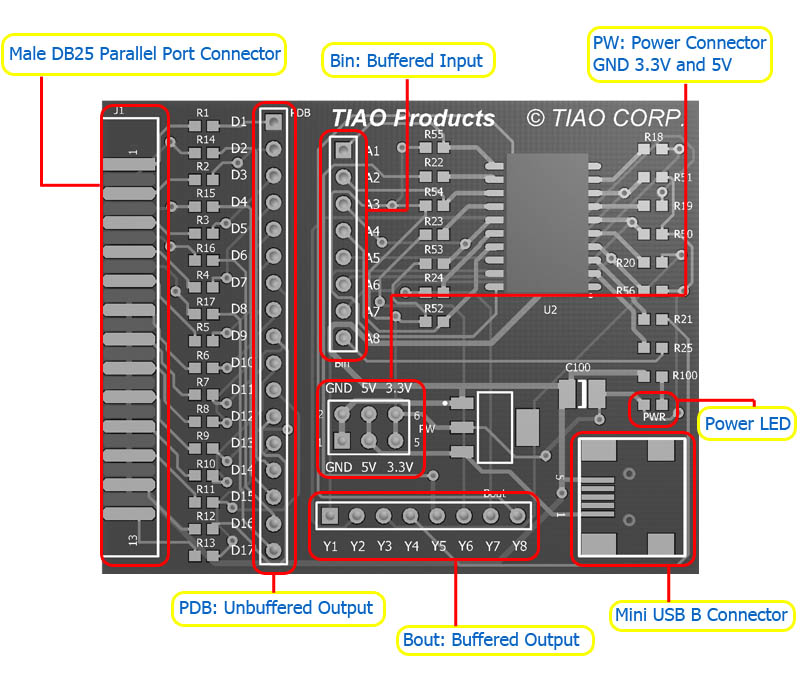Difference between revisions of "Universal JTAG User Manual (Parallel)"

10 PCS, 10cm x 10cm, 2 layers prototype for $38.80 shipped!
(→Board layout) |
(→Board layout) |
||
| Line 32: | Line 32: | ||
PDB is the header which directly connected to DB25's pin from 1 to 17 via a 100 Ohm resistor. E.g header D1 is connected to Pin 1 of parallel port via 100 Ohm resistor, header D9 is connected to Pin 9 of parallel port via 100 Ohm resistor, etc. | PDB is the header which directly connected to DB25's pin from 1 to 17 via a 100 Ohm resistor. E.g header D1 is connected to Pin 1 of parallel port via 100 Ohm resistor, header D9 is connected to Pin 9 of parallel port via 100 Ohm resistor, etc. | ||
| − | Bin is the buffer | + | Bin is the buffer input header. We use 74HCT244 as the buffer chip. |
| + | Bout is buffer output header. | ||
| + | |||
| + | Y1 is the buffered output of A1 | ||
| + | Y2 is the buffered output of A2 | ||
| + | and so on... | ||
=== Buffered or unbuffered === | === Buffered or unbuffered === | ||
Revision as of 22:19, 29 November 2009
Buy various JTAG cables for your Satellite Receiver, Cable Modem, Wireless Router, Standard Wiggler from http://www.easymg.com and http://www.diygadget.com
Contents
Why you need an universal JTAG adapter?
There are many different JTAG cables available in the market, often they are not compatible to each other. The problem was cause by the software. JTAG standard only defines a few hardware pinouts. However there is no standard definition on the PC side, e.g. which DB25 pin is for TDI? This is really depending on the software, some JTAG softwares may assume TDI is connected to pin 2 of DB25, but others may assume it is on pin 3. Even for the JTAG connector side, there are many different pinouts, 20 pin JTAG, 14 PIN, 12 PIN, 10 PIN etc... in a nutshell, you need a JTAG cable/adapter is flexible enough to allow you configure it for different softwares/programmers so you only need to invest on one JTAG adapter.
What is our universal JTAG adapter?
Our parallel universal JTAG adapter allows you to easily configure it to be a buffered or unbuffered JTAG. With provided flexible jumper wire you can move the pin configuration easily to suit different programmers.
Board layout
PW is the power output. Remember this board utilizes the USB power, which by default only provides 100mA at 5V. If you connect the power header to a component requires more current, it will damage your USB port.
PW provides two GND, two 5.0V and two 3.3V outputs.
PWR is a power on LED. When USB cable is connected, the LED will light. If you want to use it in unbuffered mode, you do not need to connect the USB cable.
PDB is the header which directly connected to DB25's pin from 1 to 17 via a 100 Ohm resistor. E.g header D1 is connected to Pin 1 of parallel port via 100 Ohm resistor, header D9 is connected to Pin 9 of parallel port via 100 Ohm resistor, etc.
Bin is the buffer input header. We use 74HCT244 as the buffer chip. Bout is buffer output header.
Y1 is the buffered output of A1 Y2 is the buffered output of A2 and so on...
Buffered or unbuffered
The product comes with 6 x 50cm color coded flexible cable and 6 x 10cm color coded flexible cable.
If you want to use the adapter in unbuffered mode, you only use the 6 x 50cm flexible cables. Do not connect USB cable to your PC in this case.
If you want to use the adapter in buffered mode, you need all the cables plus you need to connect the adapter to your PC's USB port via a USB A to Mini USB B cable. Once the USB cable is connected, the PWR LED will light.
Configure it to use with TJTAG for wireless routers
In the following example, I am using Linksys WRTG54 wireless router as one example.
| DB25 | Router | Function |
|---|---|---|
| 2 | 3 | TDI |
| 3 | 9 | TCK |
| 4 | 7 | TMS |
| 5 | 1 | TRST (Not Connected) |
| 13 | 5 | TDO |
| 18-25 | 2,4,6,8,10 | GND |
Since TRST is not used, you only need 5 flexible cables.
Unbuffered mode
You just need 5x50cm flexible cable connected in such way:
Insert one end of the red flexible cable to D2, and the other end to your router's TDI, in this case is PIN 3. Insert one end of the yellow flexible cable to D3, and the other end to your router's TCK, in this case is PIN 9. Insert one end of the green flexible cable to D4, and the other end to your router's TMS, in this case is PIN 7. Insert one end of the blue flexible cable to D13, and the other end to your router's TDO, in this case is PIN 5. Insert one end of the black flexible cable to GND, and the other end to your router's GND, in this case is 2, 4, 6, 8 or 10.
Once connected, connect the adapter to your PC's parallel port, then you are all set.
Buffered mode
Buy various JTAG cables for your Satellite Receiver, Cable Modem, Wireless Router, Standard Wiggler from http://www.easymg.com and http://www.diygadget.com

10 PCS, 10cm x 10cm, 2 layers prototype for $38.80 shipped!















